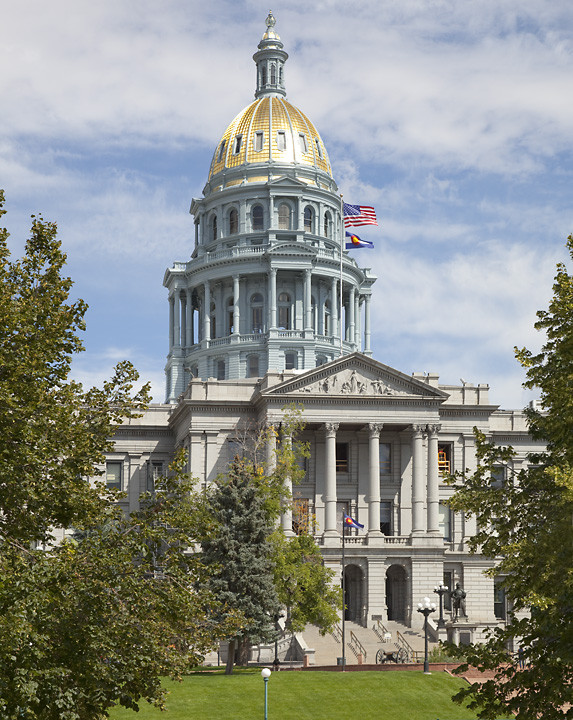Gov. Polis signs gun bills on Monday

DENVER — Democratic Gov. Jared Polis signed two bills into law Monday that both aim to reduce gun violence.
One, known as the “Isabella Joy Thallas Act”requires people to report lost and stolen firearms. Thallas was a 21-year-old Denver woman who was murdered with a stolen rifleas she and her boyfriend were walking his dog. Her sister, brother, grandmother and mother watched Polis sign the bill into law.
“It's not just about her,” said her mother, Ana Thallas. She said she’s worried about children staying safe in schools, grocery stores, and shopping malls. “The gun violence is out of control. Somebody has to do something, but what saddens me and hurts the most is that it takes a mother of a murdered daughter to stand up and speak and try and make a change and a difference in this state.”
The new law only carries a minimal fine, so backers hope the true impact will be in raising awareness through education and outreach.
“We talk a lot about responsible gun ownership, but we don't want to take accountability when it comes to really defining what that is in Colorado. We’re making a clear definition of what that is today,” said Democratic sponsor state Rep. Leslie Herod.
The other bill signed by Polis, House Bill 1106, requires people to safely store their firearms. Failure to do so could result in a fine between $250 and $1,000. Licensed gun dealers would also be required to provide a locking device with new gun purchases.
The measures passed almost entirely along party lines. State Rep. Donald Valdezwas the only Democrat to join with Republicans to vote no on the safe storage proposal. Valdez did back the lost and stolen reporting requirement.
“Most gun owners, we store our guns safely,” said Democratic state Rep. Monica Duran, one of the bill’s main sponsors. “But it's changing the mindset, right? For those who own a firearm, to make sure that they're storing it in a place where a child cannot get ahold of it or anyone who shouldn't have access, doesn't.”
Democraticstate Sen. Jeff Bridgessees the new law as a narrow policy, one aimed at preventing accidental shootings and suicides in particular.
“We have one of the highest teen suicide rates in the entire country. And we know that even though 4 percent of suicidal acts are done with firearms, that 4 percent of attempts accounts for 40 percent of deaths," Bridges said. "If we can reduce the number of attempts using a firearm, we can have a dramatic impact on cutting the number of teens who died by suicide here in Colorado.”
Opponents say the laws take away constitutional rights and are a slippery slope to even more Second Amendment infringements. Some are also concerned that requiring a gun to be stored in a certain way won’t save lives and could actually make it more difficult for people to defend themselves.
These proposals were already making their way through the Democratic-controlled state legislature prior to the March mass shooting at a King Soopers in Boulder. Legislative leaders say different proposals to strengthen background checks and other possible loopholes in the wake of the shooting are also in the works, although nothing has been introduced yet.
Colorado’s key pandemic metricsremain a vexing mix of promising and worrisome. Cases have stayed persistently high and the state’s positivity rate is above the 5 percent level public health leaders watch closely. Hospitalizations are much lower than the fall surge, but they are near 500, much higher than a few weeks ago.
More transmissible variants continue to spreadand are estimated to now make up a majority of new cases in Colorado.
Projections from the team at the Colorado School of Public Health spotlight a few possible routes. If people can avoid cutting loose and partying like it’s 1999(or 2019 for that matter) and keep up with precautions like wearing masks and avoiding crowded indoor settings while vaccinations multiply, a smoother exit could be just up ahead.
“I think we can hopefully say the end is in sight,” said Dr. Jon Samet, an epidemiologist and the dean at Colorado’s School of Public Health, who directs COVID-19 modeling for the state.
The modeling, which is regularly shared with the governor, his team and local public health leaders, also maps out a much more dire scenario. Assuming rapid growth in COVID variants that are now the dominant strains in Colorado, plus removing the state’s mask mandate, its color-coded dial and a dramatic easing of voluntary precautions taken by the public, then Colorado coronavirus hospitalizations could eclipse early December’s peak of nearly 1,900 by late June.
And at least some, but certainly not all, of those elements are happening now. The state has eased its mask mandate, releasing rural counties with low incidence levelsexcept for schools, government buildings and personal services settings, while the most populous counties keep some form of mandatory masks in indoor public settings.
When the state’s dial expires, counties in Green Level will likely drop it altogether, while most Front Range and rural resort counties maintain their own version of it for at least another month.
So that leaves a key part of Colorado’s trajectory up to the behavior of individuals.
“I think it's going to be an important month for us ahead. I think that's the bottom line. I think people, like it or not, just need to hang in a little bit longer, do the right stuff (to protect themselves and others),” Samet said. “Of course the most critical piece of personal action is getting vaccinated.”



